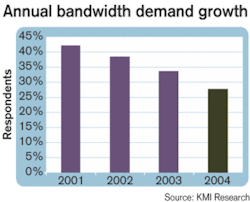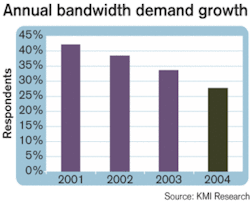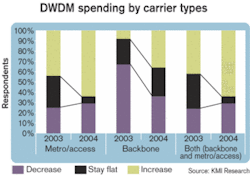'04 recovery: Is it for real?
When the telecommunications industry began to decline in late 2001, a prolonged downturn seemed inconceivable. The previous several years had seen amazing growth, and demand for bandwidth didn't appear to be slowing. At most, the recovery was "one year out."
For the next two years, the chorus of "one year out" continued. It grew louder in the summer of 2003 with announcements of a rebound from manufacturers, analysts, carriers, and investors. The stock market responded, raising share prices for telecom equipment providers.
Now, 2004 may be the turnaround year. But is the recovery for real this time? How do the factors prompting this current sense of anticipation differ from expectations over the past two years?
The reason for an expected turnaround in the telecom industry over the past two years has been the assumption that bandwidth demand is growing at the same rate it grew in the late 1990s. This is simply not the case. Yes, perhaps people are sending more e-mails with more attachments and perhaps people are surfing the Web longer when they're online, but this does not justify an annual doubling of bandwidth demand, particularly in North America and Europe. Bandwidth demand is still growing and is eating up capacity on networks. However, it's doing so at a much slower rate today.Although people talk about videoconferencing, video on demand, interactive gaming, and other applications that are supposed to eat up bandwidth, these technologies are still new and haven't had the maximum impact they could have potentially. In KMI's "Optical Networking Survey 2003" of carriers worldwide, 121 respondents provided input on bandwidth demand expectations. The average response for bandwidth demand growth is 35% for 2003 and 27% for 2004 (see Figure 1). Only 20% of the respondents expect a pickup in bandwidth demand rates next year. The rest expect slower growth, similar growth rates, or according to 2% of the respondents, a decrease in bandwidth demand.
Using the past growth in bandwidth demand to justify predictions for a dramatic turnaround in the sector is misleading. With a continued slowdown in growth rates, bandwidth demand cannot be the only driver for an increase in equipment purchases in 2004. So what else will be the catalyst?
One driver is the need to upgrade existing networks to handle traffic with flexibility by adding more sophisticated capabilities for dynamic routing. With legacy networks optimized to handle voice traffic and the growth of data applications at the edge, aggregation equipment such as next-generation SONET/SDH and traffic management equipment such as optical add/drop multiplexers and optical crossconnects are catching carriers' interests. These products route traffic efficiently and aggregate lower bit rates and multiple protocols onto metro core networks. They also help to link DWDM backbones to metro networks.
Ethernet line cards composed more than 40% of total line-card purchases in 2002, according to 14% of the carriers responding to KMI's survey. For 2005, 36% of the survey's respondents expect Ethernet line cards to compose more than 40% of their total line-card purchases. Data-friendly transmission platforms will become more prevalent in carriers' purchase patterns as advanced services—SAN applications, long-distance virtual private networks, video applications—require network equipment that can aggregate lower bit rates and multiple platforms from end users. This equipment will be in the metro space and long-haul (LH).
This year, the DWDM market improved slightly, reflecting the pickup in metro deployments as optics move to the network edge. For a sustained recovery, LH DWDM will have to climb out of the basement. When it does, these deployments won't bounce back to levels seen in the boom years; we can expect a more mature market in which maintenance, technology upgrades, and occasional network expansion generate demand.
Backbone-network providers expect a larger increase in DWDM deployments in 2004 relative to 2003 than metro network providers or carriers with a combination of metro and backbone networks. Although the outlook remains fairly positive for spending by metro and metro/backbone carriers, the change in anticipated spending reported by the backbone respondents indicates an upswing specifically in LH DWDM deployments (see Figure 2).Capacity filling up on major routes is driving service providers' DWDM spending expectations. Respondents to KMI's survey indicate that the trigger point for planning the deployment of additional equipment to accommodate requirements for increased capacity is likely to come when capacity utilization hits somewhere in the 40–70% range, depending on the type of network (LH, metro, etc.) and the service provider's practices.
Although 63% of the respondents indicate that their network capacities are under this range, 37% are in the range of considering network upgrades. And while bandwidth demand growth is slowing to a percentage rate in the low 20s in North America and Europe, it still contributes to demand for wavelength cards and transmission systems.
The build-at-all-costs approach of the late 1990s when bandwidth demand growth drove network deployments has changed to an approach of maximizing efficiencies and maintaining existing networks. Growth will be more steady and gradual in the future. The resuscitation of LH DWDM, nearing of capacity limits on some networks, and growth in data services will drive the overall optical-networking market. The necessary drivers for a recovery, although gradual, have finally started to come together so that 2004 will indeed be the "one year out" we have all been waiting for.
Michael Arden is an analyst at KMI Research (Providence). He can be reached at [email protected].


